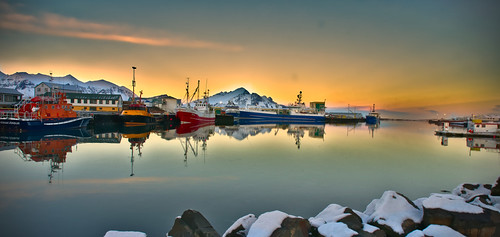So on day two, we set out, counter-clockwise along the coast. Everything seemed great, until about 100 miles from the city, when the pavement ended. After that, it was like driving up someone's farm driveway for the next ten hours. Where the volcano had come through, they graded the lava, put new reflectors up, and that was the road. Where there were hills, they salted the dirt in an attempt to keep it from freezing. Only problem with that was that sheep would come lick the road because they liked the salt. Sheep wander free throughout a district during growing season; and by law if you hit one it's on you to find the owner and compensate hir. I had no intention of hitting any sheep. That would be cruel, and messy. I had no idea what kind of insurance we had, but I suspected disentangling sheep innards from the radiator wasn't covered. Thus, slow going.
Plus, the landscape was profoundly beautiful in a way that no-place we'd been before could have prepared us for. My dad commented "I've never doubted that the space program was real, but--seeing this place--I understand how someone might think the moon footage was faked."
Periodically you would see a sign saying something like "Kirkjubæjarklaustur 249". That's a real place. I've been, but I can't pronounce it, and I don't know what it means. Kirk means "church" so it's least possible that it translates to "The Church of the Poison Mind," but I doubt it. However, knowing how many kilometers away it is doesn't help much when you don't what the road is going to be like. It would be better measured in hours. Or sheep.
It was quite late by the time we arrived at our first farm, outside a town called Höfn (but pronounced "hop"). Höfn means "harbor" ... one great thing about Iceland is that place names are generally descriptive. So anyplace that ends in "höfn" is likely to have boats. There is generally an adjective attached (i.e., Reykjavik means "smoky bay") but not so in this case. We later visited a lake called Myvatn that was invested with gnats, and I later found out the name means "gnat lake". See? Easy!
We slept well, and when we got up the next morning we headed into Höfn proper for some gas and snacks, only to hear a rhythmic thumping from the front right tire as soon as we hit the paved town streets. I pulled over to check it out, and discovered a hex bolt had embedded itself in the tire sometime the day before. Luckily, the tire had held, but we didn't want to chance driving on it any further.
Luckily, according to the map from the rental car company, they had an agent right in Höfn! We located it on the map and headed there, only to discover the address in question was a house on a residential street with nobody around. Not sure what else to do, we stopped at a business (a propane merchant as it happened) to ask for guidance.
Most people in Iceland know at least some English, but the further you get from Reykjavik, their fluency diminishes. And we knew about as much Icelandic as I shared above. Everybody whom we met was glad to communicate with us, though, and this woman was no exception. She listened to my sad tale and laughed when I got to the point about the deserted house.
"He is also police chief," she told me. "First you go to coffee shop. If he is not in coffee shop, try police station!" That sounded about right! She explained how to find it on a town map, which she handed me. I took out my wallet to pay for the map, and she said "Oh no, is free; you take!"
Grateful for her advice, I wanted to buy something. I saw she had a coffee machine, and asked if I could have a cup. She nodded and disappeared, and came back bearing a tray with a cloth napkin, china cup and saucer, matching pitcher of milk and bowl with sugar cubes wrapped in paper. It looked more like something you'd get from room service in a nice hotel (for $12 plus tip) than a gas station waiting room; I pictured the grungy Mr. Coffee with Styrofoam cups and can of powdered "milk" that a place like this would have at home.
I took my wallet out, ready to pay for the coffee, and she waved me away. "Is free; you take!" Seriously, lady? You're not making this easy on me. I wondered if I was going to head back to the car with one of the backyard grills they were selling and tell my dad, "Don't ask questions!"
We followed the propane lady's instructions and found the coffee shop. Our man wasn't there, so we tried the police station. He wasn't there, either, but they got him on the radio and told them our problem. We were directed to a nearby garage, where they quickly changed the tire. No money was exchanged there, either; apparently the chief was good for it.
All of this was in such stark contrast to what we were used to, and a pleasant surprise given some of our previous travel adventures. We returned eleven years later with my mom and a family friend and had a similarly positive experience. As Iceland gets "discovered" by Westerners, some of whom have already been causing problems in heavy tourist areas, I hope this is one aspect of it that doesn't change.




















